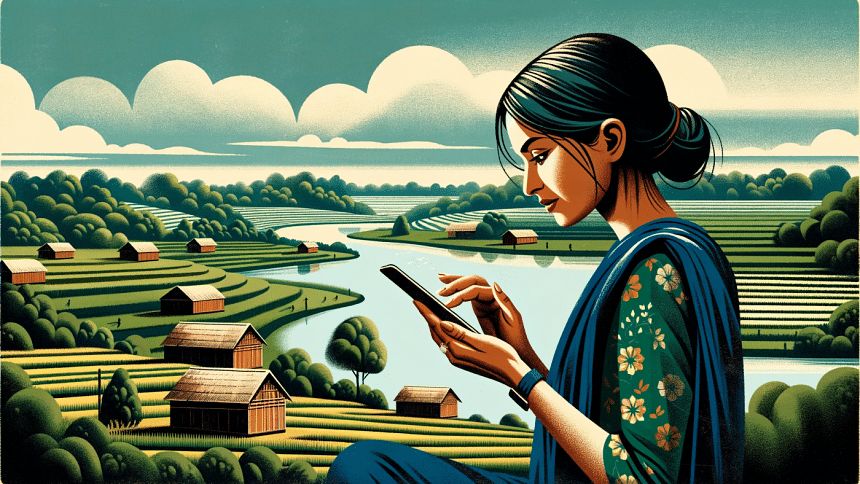Where are Bangladesh's digital consumers?

In a surging consumer market of 170 million people, how large is the digital economy? Over the last 8 years, these two facts have come up quite often: Bangladesh has the 8th largest population in the world, and BCG forecasts how our Middle Affluent Consumers (MAC) segment will grow from 12 million in 2015 to 34 million by 2025.
We are 13 months away from 2025 and one might wonder where those 34 million MAC consumers are. While this isn't meant to be a criticism of a forecast made a decade ago - it does provide insights into today's consumer ecosystem in Bangladesh.
While the actual size of the consumer market and their respective disposable incomes can be very hard to decipher - one conclusion that's slightly easier to draw is that a big portion of this consumer base has not yet joined the digital economy.
While a population base of 170 million is definitely a large market, once you factor in smartphone penetration and internet adoption (the two critical ingredients for a digital economy before we even get to disposable income) - the market becomes significantly smaller.
Between 2015 and now, smartphone usage has increased from maybe about 25-30 million users to more than 60-70 million unique users. Investments in local assembly of smartphones have driven down prices and made smartphones accessible to a large segment of the population. At current growth rates, the country is expected to have over 100 million unique users within the next 3-5 years.
While neighbouring India has had its 'Jio moment' over the last decade, mobile broadband internet adoption still lags in Bangladesh. BTRC data claims over 130 million internet users, but if you dig deep enough into the fine print you will realise that their definition of an internet user is "anyone who has used 125 kb of data in the last 90 days". There's no clear data on how many Monthly Active Users there are who consume at least 1 GB of data (the basic minimum to consider someone a "digitally native consumer") but by back calculating from publicly listed telcos we can come to a figure of about 25-30 million who fall into that category. Still significant, but still shy of the 50-100 million digital consumers we were hoping to see by 2025.
Thus, if you think of the intersection of consumers who have disposable incomes, a smartphone and are digitally native, the current market size seems to be closer to just 15-25 million people (limited primarily by disposable incomes). While numbers on smartphones and internet users are quantifiable, it's nearly impossible to get a more detailed idea of the numeric breakdown of the actual size of the various incomes/consuming cohorts in Bangladesh.
BCG's 2015 report on the growing consumer market in Bangladesh, unfortunately, clubs both "established" (household monthly incomes between $401 to $650) and "affluent" (household incomes greater than $650) into one cohort named "middle-affluent consumers (MAC)". Bangladesh Bureau of Statistics' (BBS) latest household income survey only shares household income distribution by decile, leaving us with the approximate spread of the 2nd top 10% (about 17 million people) with an average monthly household income of $430 and the top 10% (another 17 million people) with an average monthly household income of $1,200.
Forcing us to go off of comparables rather than depending on GDP per capita or other household income distribution data. The largest mobile financial service (MFS) backed by global investors has about 70 million registered users (online and offline) but only about 2-2.5 million monthly active transacting users on their app (for online payments). Not to be confused with their main use case, which is P2P send-money transactions (which has about 40 million active users across their app and USSD interface). Meanwhile, Bangladesh's largest food delivery app has about 750-800k monthly active transacting users and the largest ride-hailing app has about 1.5-2m MAUs.
While these three examples only highlight a small sample size - it begs the question of if you're not ordering food via an app, or you're not using an app-based ride-hailing platform, nor are you paying using the country's largest MFS/wallet at least once in 3 months - are you really a digitally native consumer?
These examples above highlight that only 4-8 million users (assuming a 90-day active customer cohort) out of the 25-35 million segment are currently part of the digital economy. It will likely take another 5-8 years for this digitally native consumer base to grow to 25-40 million people (growing at 15-25% CAGR optimistically). This growth will be driven by these factors: a drastic increase in discretionary spending of the top 5% of households (8.5 million people), lifestyle changes of the top 20% of households (34 million people), and an overall increase in digital commerce penetration due to increase in smartphone and internet adoption amongst the top 50% of households (85 million people).
So how does the above information help us set our strategy for the Bangladesh market?
Setting expectations of current market size and future TAM within the next 5-10 years
If you come into the ecosystem looking at the $5 cappuccinos & $40 dinners around Gulshan (the diplomatic/expat neighbourhood) and assume that the rest of the 34 million 'MAC' consumers will act and consume the same way – you're off to a wrong start. But if your investment or startup's thesis realistically identifies the current market to be 2-5 million users which will grow to 10-15 million users over the next 5 years, you might be off to a better start. This growth could be because of an increase in digital commerce penetration, an overall increase in the size of the consumer market, and an increase in the consumption per user.
Take, for example, Sturgeon's first investment in Bangladesh – GoZayaan, a leading Online Travel Agency (OTA). Since we came on board as investors nearly 18 months ago, the company's monthly transacting users have grown by 300% and repeat customers are spending on average 15% higher than a year ago.
International air travel in Bangladesh has increased from 9m passengers per year last year to more than 12m this year. Stretching the existing airport infrastructure to its limit as it can only handle 8m passengers per year, that is until the new airport terminal kicks into operation any month now tripling existing passenger handling capacity.
Conclusion
Over the last few decades, Bangladesh has achieved what very few developing countries have been able to do in such a brief period. Primarily attributed to a global working diaspora, millions of women gaining employment in the apparel industry and a rising domestic consumer market that is projected to be the 9th largest in the world by 2030, as per BCG research.
For many years, the Bangladesh opportunity was overshadowed by its neighbour India with 1.4 billion people. And to the east, it never quite fit into the ASEAN growth regions despite much higher GDP growth rates. But with a population density that is 3x greater than India and a middle-income consumer base that is concentrated primarily in just two cities – the opportunity for businesses to scale up rapidly with minimal customer acquisition cost is massive.
While 2015 might have been too early, by 2030 the opportunity to invest in the highest growth period of digital adoption will have passed. Capital-efficient business models that understand and incorporate the realities on the ground as they are today and as they will develop over the next 5-10 years will deliver the types of returns that early venture investors in emerging markets should be targeting and expect.
Waiz Rahim is a Venture Partner at Sturgeon Capital, a private equity firm.
The opinions expressed in this article are the author's own and do not necessarily reflect the editorial stance of the newspaper.

 For all latest news, follow The Daily Star's Google News channel.
For all latest news, follow The Daily Star's Google News channel. 








Comments